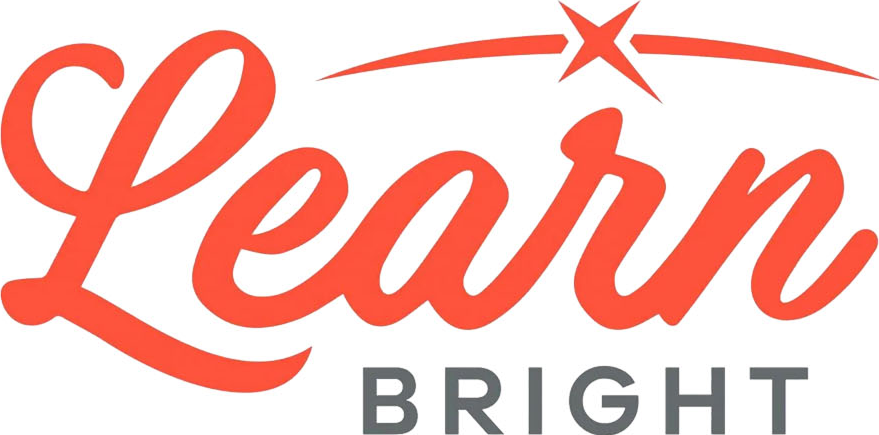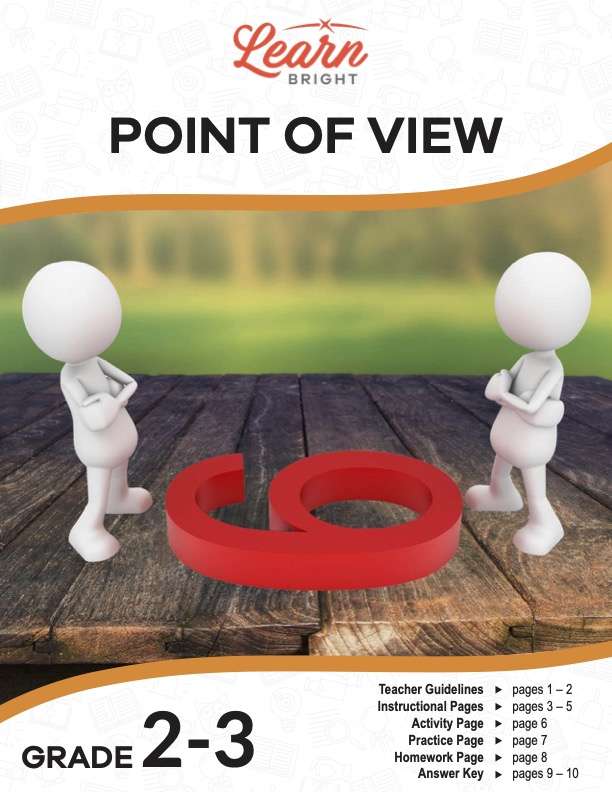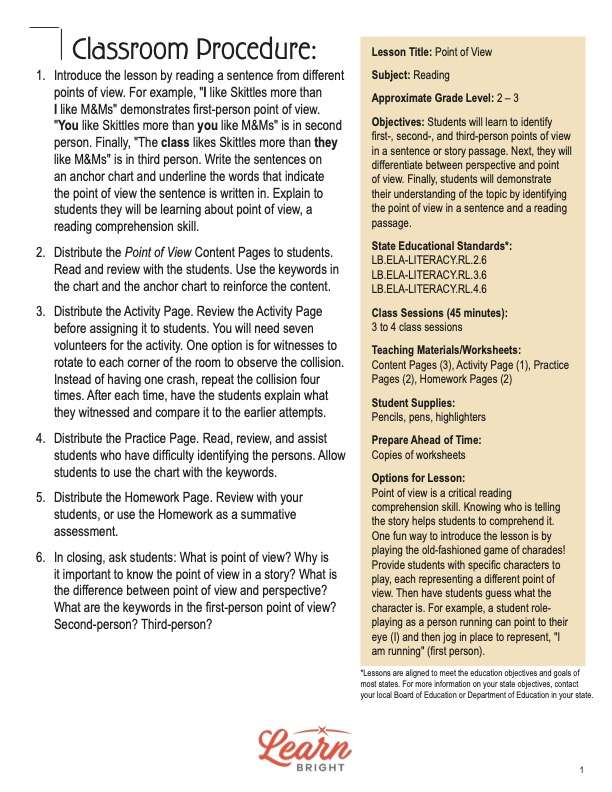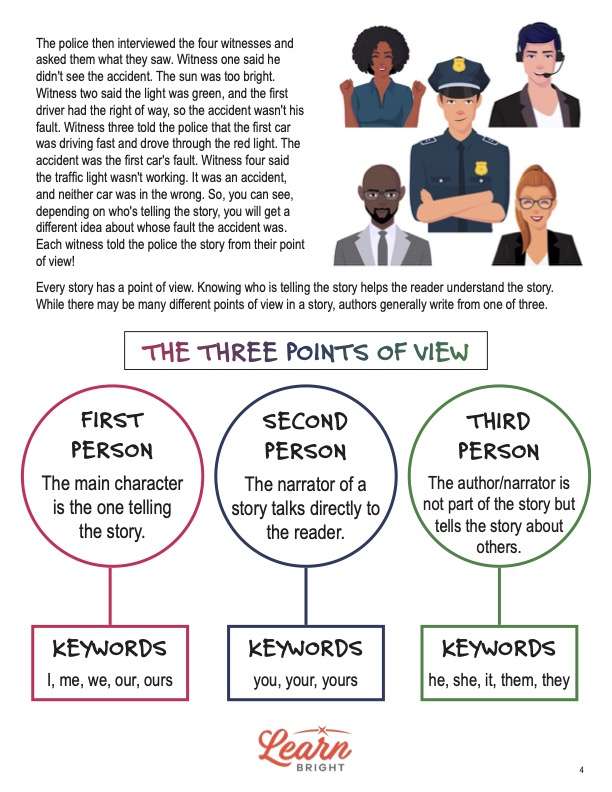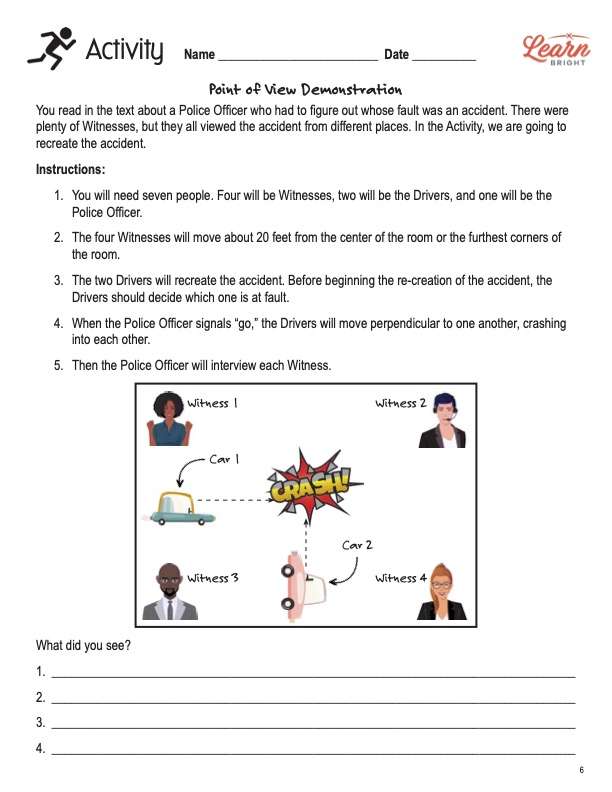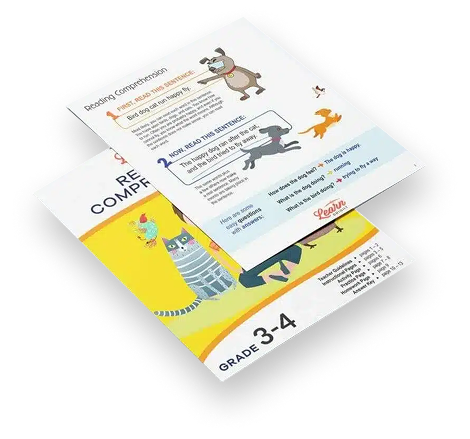Description
What our Point of View lesson plan includes
Lesson Objectives and Overview: Point of View explains this skill that helps with comprehension. Students will learn to identify first-, second-, and third-person points of view in a sentence or story passage. Next, they will differentiate between perspective and point of view. Finally, students will demonstrate their understanding of the topic by identifying the point of view in a sentence and a reading passage. This lesson is for students in 2nd grade and 3rd grade.
Classroom Procedure
Every lesson plan provides you with a classroom procedure page that outlines a step-by-step guide to follow. You do not have to follow the guide exactly. The guide helps you organize the lesson and details when to hand out worksheets. It also lists information in the yellow box that you might find useful. You will find the lesson objectives, state standards, and number of class sessions the lesson should take to complete in this area. In addition, it describes the supplies you will need as well as what and how you need to prepare beforehand.
Options for Lesson
In the “Options for Lesson” section of the classroom procedure page, you will see some suggestions for additional activities or ideas to add to the lesson if you want to. Point of view is a critical reading comprehension skill. Knowing who is telling the story helps students to comprehend it. One fun way to introduce the lesson is by playing the old-fashioned game of charades! Provide students with specific characters to play, each representing a different point of view. Then have students guess what the character is. For example, a student role- playing as a person running can point to their eye (I) and then jog in place to represent, “I am running” (first person).
Teacher Notes
The paragraph on this page gives you a little more information on the lesson overall and describes what you may want to focus your teaching on. The blank lines are available for you to write out any thoughts or ideas you have as you prepare.
POINT OF VIEW LESSON PLAN CONTENT PAGES
What Is Point of View?
The Point of View lesson plan contains three pages of content. It starts out by asking students to look at the picture at the top of the page. What do you see? A rabbit, a duck, or both? Depending on your point of view or your way of looking at things, you will see the rabbit or duck and then both. Did you know that when you read, the author is writing from a particular point of view? The point of view in stories is the author’s way of looking at things, just like how you first saw the rabbit or duck!
Sometimes teachers will talk about voice. Voice refers to the sentences, paragraphs, word choice, and point of view authors use to tell stories. Short stories and novels may have several voices—the narrator, author, and characters. All of them are used to tell the story from different points of view. Let’s use an easy example that helps you understand this concept.
Content Scenario
There was a car accident on Main Street. When the police arrived, they found out there were four witnesses to the accident, not including the two drivers. Each witness stood on a different corner and witnessed the accident from other places. The police interviewed the drivers first. The first driver said the second driver ran a red light and rammed into his car. The second driver said the first driver was running the red light, and the accident was the first driver’s fault.
The police then interviewed the four witnesses and asked them what they saw. Witness one said he didn’t see the accident. The sun was too bright. Witness two said the light was green, and the first driver had the right of way, so the accident wasn’t his fault. Witness three told the police that the first car was driving fast and drove through the red light. The accident was the first car’s fault. Witness four said the traffic light wasn’t working. It was an accident, and neither car was in the wrong. So, you can see, depending on who’s telling the story, you will get a different idea about whose fault the accident was. Each witness told the police the story from their point of view!
Every story has a point of view. Knowing who is telling the story helps the reader understand the story. While there may be many different points of view in a story, authors generally write from one of three. With first-person point of view, the main character is the one telling the story. In second person texts, a narrator or the author tells the story but talks to the reader as if they are part of the story, too. Finally, third-person involves a narrator or author, but they are not part of the story. Instead, they are telling the story about others.
Point of View vs. Perspective
Sometimes we confuse point of view with perspective. The point of view is who is narrating the story. Perspective is the lens we use to understand what we read. For example, let’s say you recently suffered an injury while playing your favorite sport. The injury will keep you out of action for a couple of weeks. You read a story written about someone who is injured like you. You know precisely how that person feels because you feel the same way!
In this instance, your perspective is empathy—you understand and share the feelings of the injured person. On the other hand, the point of view is the third person. The author is not part of the story. The author is telling a story about a person who was injured while playing sports.
Suppose the author is narrating the story but is talking directly to you—the reader—about what happened. Now the point of view is second person. Finally, the story is in the first person if the character talks about their own sports injury. Oh, and by the way, your perspective does not change. You are still empathetic toward the injured character in the story!
POINT OF VIEW LESSON PLAN WORKSHEETS
The Point of View lesson plan includes three worksheets: an activity worksheet, a practice worksheet, and a homework assignment. Each one will help students solidify their grasp of the material they learned throughout the lesson. You can refer to the classroom procedure guidelines to know when to hand out each worksheet.
CAR CRASH ACTIVITY WORKSHEET
Using the information from the scenario in the content pages, students will reenact the car crash. There should be seven students at a time to be the witnesses, drivers, and police officer. First, the four witnesses will move about 20 feet from the center of the room or to the furthest corners. The two driver will then recreate the accident (but only after they decide which one will be “at fault”). The police officer will yell “Go!” to signal the drivers to crash and then interview the witnesses. Whichever students plays the police officer will write the witnesses “statements” on the lines at the bottom of the page. Students should take turns reenacting the crash, or you could have groups of students in different areas to do the activity at the same time.
POINT OF VIEW PRACTICE WORKSHEET
There are two parts to the practice worksheet. First, students will mark 10 statements as either first person, second person, or third person. An example is done for them for reference. The second part requires students to write a sentence in each of the three points of view.
SHORT STORY HOMEWORK ASSIGNMENT
For the homework assignment, students will read three passages. They must write which point of view each story is in. Then they will circle the keywords that helped them figure out the point of view of the passage.
Worksheet Answer Keys
The lesson plan provides answer keys for the practice and homework worksheets at the end of the PDF document. Some students’ responses may vary given the nature of some of the prompts. However, for the most part, their answers should match the answer keys. If you choose to administer the lesson pages to your students via PDF, you will need to save a new file that omits these pages. Otherwise, you can simply print out the applicable pages and keep these as reference for yourself when grading assignments.
